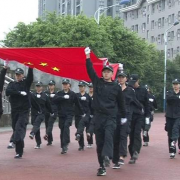with?with的用法请问一下with的用法有哪些
来源:择校网 时间:2025-02-11 22:51:46
一、with的用法请问一下with的用法有哪些
with的用法如下:

1、表示使用工具、手段等,意为“用……”。例如:We can walk with our legs and feet。我们用腿脚行走。
2、表示伴随,意为“和……在一起”。例如:Can you go to a movie with me?你能和我一起去看电影吗?
3、表示一种关系或适应范围,意为“关于、对于”。例如:What’s wrong with your watch?你的手表怎么了?
4、表示人或物的特征,意为“带有”、“具有”。例如:They have no money with them。他们没带钱。
5、表示工具、手段,意为“以……”、“用……”。例如:We listen with our ears。我们用耳朵听。
关键词解释
with英[wɪð]美[wɪð]
prep.和…在一起;和;同;跟;有;具有;带有;用;使用;以;借;
[例句]She is a doctorwitha strong sense ofvocation。
她是一位具有强烈使命感的医生。
二、with的用法归纳
with的用法如下:
with是介词,在英语里面的应用非常广泛,为大家总结了一下其用法。
1、表示和、跟、同……一起(行为上的一起)。此类动词搭配很多,如:be with,go with,sit with,stand with,mix with,hang out with,play with,work with,cooperate with,fight with……
I wan tobe withyou.我想和你在一起。
2、表示和、跟、同……一起(吃)或搅拌在一起,常用于食物间的搭配。
Sushi is deliciouswithmustard.寿司跟芥末一起吃很美味。
Coffee taste betterwithmilk.咖啡加牛奶更好喝。
3、do sth. with sb.与某人一起做某事。
If you want to see a moviewithme, you have to listen to me.如果你想和我看电影,你得听我的。
4、表示用某种工具、方法、手段等。
She is writingwith a chalk.她正在用粉笔写字。
I always go to schoolwith a bike.我总是骑自行车上学。
5、表示拥有某物,有某种特质、特质等
She is beautiful a girlwithblond hair.她是一个金发美女。
He is a manwithhot temper.他是个暴脾气的人。
6、表示原因或者理由。
With so many housework to do, I won't go out tonight.很多家务要做,我今晚就不出去了。
She jumped up with pleasure.她高兴地跳了起来。
7、表示在……的帮助下:with the help of sb.=with sb's help
I did it with your help.
在你的帮助下我做到啦。
With the help with my friends, I finished my job on time.在朋友的帮助下,我按时完成了工作。
8、表示让步
With all his money, he's yet unhappy.
尽管他有这么多钱,他还是不开心。
9、常用的短语:
agree with sb/sth同意某人或某事
deal with sth= do with sth处理某事
fall in love with sb/sth爱上某人/某物
10、be 形容词 with
be satisfied with对...满意
be content with sth对...满足
三、与with区别
with的三种用法表示“和……一起”,相当于together;表示“用,使用”,相当于use;表示“有,拥有”,相当于have。
一、表示“和……一起”,相当于together。
例1:The little boy often plays with his toys.这个小男孩经常和他的玩具一起玩。
例2:It's dark. I want to go home with you.天黑了。我想和你一起回家。
例3:You are a bad man. I don't want to talk with you any more.你是个坏人。我再也不想和你谈话了。
注意
together一词也表示“和……一起”,它一般单独用,或者和with连用。
例1:Let's go to school together.让我们一起去学校。
例2:She went to the supermarket together with me.她和我一起去超市。
二、表示“用,使用”,相当于use。
例1:You should cut off the net with this sharp knife.你应该用这把锋利的刀割开网。
例2:We usually say hello to each other with mobile phones.我们通常用手机去互相问候。
例3:Billy draws the picture with a pencil.比利用铅笔画画。
注意
use意思是“使用”,和介词with有异曲同工之妙,小学阶段也常考察,它有2种词性,分别为名词和动词,作名词时有短语make use of,意为“使用”,作动词时经常用固定句式“use……to do……”。
例1:These books are good for you.All of you should make good use of them.这些书对你们有好处。你们所有人都应该好好利用他们。
例2:We always use email to chat with each other.我们总是用电子邮件去互相交流。
三、表示“有,拥有”,相当于have。
例1:She is a beautiful girl with a long hair.她是一个有着长头发的漂亮女孩。
例2:I would like to live in a house with a big garden.我想住在一个带大花园的房子里。
四、with结构的几种用法
结构一with 宾语 形容词
She often sleeps with the windows open.她常开着窗睡觉。
You shouldn’t speak with your mouth full.你不应该满嘴巴食物说话。
结构二with 宾语 副词
He stood before his teacher with his head down.他低着头站在老师面前。
He was lying on the bed with all his clothes on.他和衣躺在床上。
结构三with 宾语 名词
He died with his daughter yet a schoolgirl.他去世时,女儿还是个小学生。
结构四with 宾语 介词短语
She said good-bye with tears in her eyes.她含着眼泪说了声再见。
He was asleep with his head on his arms.他头枕着胳膊睡着了。
扩展资料
with复合结构,在句中表状态或说明背景情况该结构常做伴随、方式、原因、条件等状语。
例句:
1、With machinery to do all the work, they will soon have got in the crops.
由于所有的工作都是由机器进行,他们将很快收完庄稼。(原因状语)
2、The boy always sleeps with his head on the arm.
这个孩子总是头枕着胳膊睡觉。(伴随状语)
3、The soldier had him stand with his back to his father.
士兵要他背对着他父亲站着。(方式状语)
4、With spring coming on, trees turn green.
春天到了,树变绿了。(时间状语)
参考资料来源:百度百科-With复合结构
好了,本文到此结束,如果可以帮助到大家,还望关注本站哦!







